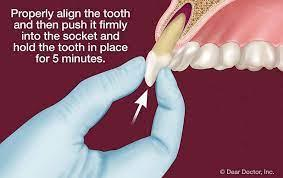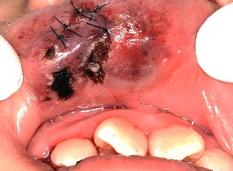Emergency Treatment For Knocked Out Teeth/Fractured Teeth
 If an adult tooth is knocked out:
If an adult tooth is knocked out:
- Stay calm
- Handle the tooth by the crown (smooth white part), not the root (yellowish pointy part).
- If the tooth is dirty, gently rinse it in milk or saline for a few seconds. Do not rinse the tooth with water.
- Holding the clean tooth by the crown, gently put it back into the hole in the gum (socket). Make sure the pointy yellowish root(s) is the part that goes into the socket. Only do this if the person is conscious.
- Get the person to hold the tooth in place by gently biting on something soft, like a handkerchief.
- Assist the person to see a dentist immediately.
If you can’t replace the tooth yourself:
- Try not to let the tooth dry out – place it in milk or ask the person to spit into a clean container and place the tooth in their saliva. You could also seal the tooth in plastic wrap.
- Do not use water to rinse or store the knocked-out tooth.
- Seek immediate advice from a dental professional.
FAQ'S
An avulsed tooth is one that has been knocked out.
A tooth can be knocked out by a blow to the mouth, or an accident involving the face. This can happen for example while playing contact sports. The tooth can be replaced in the socket successfully if you take the right action as soon as possible

Don’t panic. Get a clean handkerchief and fold it up, then hold it over the socket and bite down. Keep your jaws together to apply pressure. If you need something for the pain, don’t take any medication containing aspirin as this can cause the bleeding to get worse. Do not apply clove oil to the wound.
Maybe. The complete tooth needs to be replaced in the socket as soon as possible, ideally in under 30 minutes. But teeth have been successfully replaced up to 60 minutes after being knocked out.
Don’t touch the root. If the tooth is very dirty, rinse it with milk or tap water. Do not clean it with disinfectant or let it dry out.
Hold the tooth by the crown and put it back into the socket firmly, root first. Bite on a clean handkerchief for about 15 to 20 minutes. Visit your dentist as soon as possible

Your tooth has more chance of survival if you keep it in your cheek until you can get emergency dental treatment. This will keep the tooth in its most natural environment. If this is not possible, keep it in some milk.
If you cannot find the tooth, you may have swallowed it. If you think you may have swallowed or inhaled it, you may need an x-ray to be sure of this.
Most dentists would not recommend putting back a baby tooth in case an infection damaged the adult tooth underneath. Contact your dental team as soon as possible for advice. They may need to examine the child to check if any bits of tooth are still in the gum. There is no way to temporarily replace a baby tooth, so the only treatment is to wait for the adult tooth to appear.

A chipped or broken tooth is quite common, especially among toddlers just learning to walk or preschool children engaged in vigorous play or sports. It might not even be rough play, but just a chewed piece of ice or biting into a piece of hard candy can ultimately cause some damage. There are many kinds of injuries to the tooth that can occur, from a minor chip to a fracture (a cracked or broken tooth). It might happen to one of their baby teeth or to a permanent adult tooth.
If your child’s tooth gets chipped or broken, whether it’s a baby tooth or a permanent tooth, it is very important to call their pediatric dentist right away and schedule an emergency appointment.
A child’s permanent teeth are not fully developed, so any tooth fracture to a permanent tooth needs immediate attention. The classifications of tooth fractures and common types of treatment are as follows:
- Class 1 – Fractures or chips in outer enamel layer – For smaller chips, edges are simply smoothed over. For larger chips, they might do a composite filling (bonding).

- Class 2 – Larger fractures into the dentin layer – A common type of fracture; often sensitive to cold air and liquids. To protect the dentin, composite will be used to restore the tooth. A large fracture may require a crown or porcelain veneer, though with young children, it may be advised to wait for further tooth development and an orthodontic visit.

- Class 3 – Fractures into the tooth’s pulp – Special attention is required, since there’s the danger of bacteria entering into the pulp. For adults, this often indicates the need for a root canal. Children with still-developing permanent teeth have healthier pulps with a better supply of blood, so they can often recover on their own. If a large portion of the tooth’s crown is missing, they may need a root canal to hold a dental crown in place.

- Class 4 – Fractures onto the root of the tooth – Though this isn’t common, it is very serious and may need complete removal. If your dentist is able to save the tooth, treatment might be orthodontic extrusion, a root canal, a post-and-core technique and a dental crown.

It is important to get emergency dental treatment. Contact your dental practice as soon as possible and explain what has happened. You should still be able to contact your dental team for emergency treatment, even if the incident has happened outside normal dental practice hours.
Your dentist will assess you and may treat any facial injury. However, treatment may be limited if there is any bruising or bleeding. They may take x-rays and will check if the tooth has been re-implanted successfully. You will probably need more appointments for follow-up treatment.Some wounds may need sutures.

If the tooth has been re-implanted successfully you may not need any other treatment, as long as you keep up your regular check-ups with your dentist. If the tooth becomes loose, it can be ‘splinted’ to the teeth next to it. This means it will be temporarily attached to keep it firm until your dentist can tell whether it has been re-implanted successfully.
If the tooth is lost or doesn’t re-implant successfully, it can be replaced at first with a denture. Then, when the socket has healed fully, you can have a bridge or dental implant.
If you are playing sports, particularly contact sports, you should always wear a mouthguard.
This is a rubber-like cover that fits over your teeth and protects you against a blow to the mouth. Your dental team can have one made for you by taking an impression of your teeth and sending it to a laboratory. The laboratory then makes the mouthguard so that it fits your mouth exactly.


